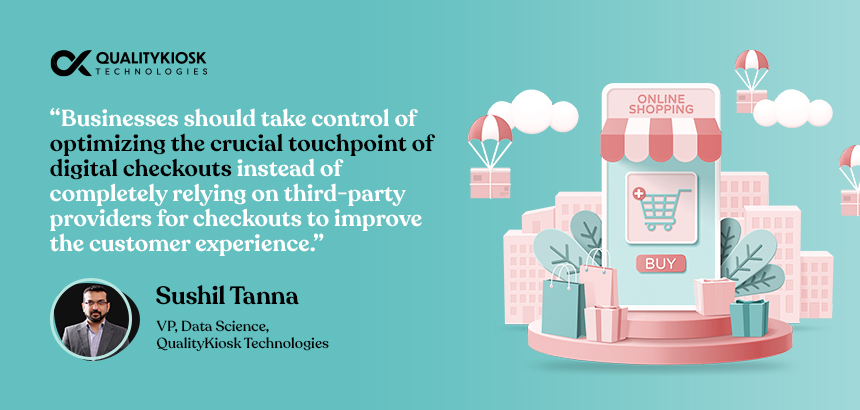Data powers customer experience.
As oversimplified as that statement might sound, there is no more accurate or effective business strategy in this data-driven era. Over 87% of business leaders rely on data insights to manage customer experiences, research from Experian revealed. It all boils down to how well a business understands its customers and their expectations. One classic example of achieving pathbreaking success through exceptional customer experience is Apple.
“You’ve got to start with the Customer Experience and work back toward the Technology, not the other way around.”
– Steve Jobs
Apple launched the iPod after thoroughly analyzing customers’ pain points concerning portable music players in the market. The outcome of that data analysis is ‘all your songs in your palm,’ It solved its competitors’ storage, battery, and usability issues and revolutionized the world. Although they went on to do that with iPhone and iPad, data-driven decision-making at the time was an innovation. But today, it is a necessity.
In the current market competition, organizations are extensively collecting and analyzing data to drive insights to boost their business growth. But with the exponential rise in real-time data, it will get difficult for an organization to manage it and maximize its potential for improved customer experience. Regardless of the amount of data the enterprise generates, it will not make sense without context.
Enter the world of data democratization
In short, data democratization is the practice of universally sharing customer data that a particular business accumulates to improve customer experience and simplify the user journey. In addition to enhancing user experience, data democratization facilitates operational efficiency and good governance. Also known as open data, the concept enables free sharing of relevant user data in an understandable format, which can be further processed to build a decisioning engine. In a nutshell, data democracy enables free access to relevant data for relevant people.
Data democratization for customer’s financial data
The exchange of customers’ financial data is fast becoming a foundational step for businesses to offer seamless digital experiences, reduce system inefficiencies and introduce new services or products. Financial plumbing is now centered around the universal availability of consumer data with a sharp focus on payment journeys and transactions.
Businesses and even governments and regulators are fast realizing the data democratization benefits of improved product innovations, secure payment processes, and customer-centric business models. European regulation of PSD2, RBI’s Open Banking push, and the launch of ONDC are all directed toward data democracy, although in different forms.
The current state of users’ financial data is highly fragmented and siloed. Data sharing has been a widespread practice between financial institutions and businesses for years, but today holders claim sole ownership of the data. While data democratization is changing the narrative by enabling users to assume absolute rights over their data, including how it is accessed and used, it has highlighted another key focus area. The financial data generated in the range of quintillion bytes every day is not being used effectively to identify, address, and optimize service delivery.
Here, banking APIs play a crucial role in enabling online payment transactions. Third party businesses use these APIs for accounts, deposits, cash receivables, retail loans, cards, trade, credit/ CIBIL score, verify personal information, and so on. Availability of fast, secure, and efficient APIs and access to the same core banking data promotes the overall development of eCommerce businesses as well as the financial industry.
Monitoring customer journey for eCommerce payments
For any eCommerce player, the appeal of its web or app design, ease of navigation, and service delivery innovation form various aspects of providing a delightful customer experience. However, it is only a completed transaction that is counted as a win. Let’s quickly understand how a payment ecosystem works.
- Step 1: Once a user confirms the order and selects the payment method, the data is encrypted and forwarded to the payment gateway through the merchant website.
- Step 2: The payment gateway assumes complete control – blindsiding the merchant – and sends the encrypted information to the merchant’s bank. The next step depends on the mode of payment.
- Step 2.1: If the user is choosing a debit or credit card, or an e-wallet, the information is sent to the service issuing organization, which in turn forwards it to the bank.
- Step 2.2: If the user chooses net banking or UPI, the request is sent to the relevant bank directly.
- Step 3: The user’s bank verifies fund availability, CVV, PIN match, and other authentication criteria. If the assessment is positive, the transaction is approved or else declined.
- Step 4: The encrypted response is forwarded to the payment gateway and sent to the merchant.
Incidentally, this critical user journey stage is handed off to a third-party payment provider. With absolutely no visibility into what is happening at the payment gateway and the kind of customer experience, businesses give away the opportunity to improve the payment phase.
Understandably, most businesses don’t offer niche services like payments. So, they rely on third-party providers for checkouts instead of taking control of optimizing this crucial touchpoint in the customer journey.
“Businesses should take control of optimizing the crucial touchpoint of digital checkouts instead of completely relying on third-party providers for checkouts to improve the customer experience.”
- Sushil Tanna, VP, Data Science, QualityKiosk Technologies
A whopping 69.99% of customers claimed to have abandoned their online shopping cart, according to a study by Baymard Institute. The top 10 reasons the claimants cited as reasons for the cart abandonment were:
- Too long/ complicated checkout process (17%)
- Website errors/ crashes (13%)
- Credit card declines (4%)
The research also opined that eCommerce businesses’ conversion rate could increase by 35.26% through better checkout design.
The stats are hardly surprising since the payment process is happening on a separate page, which historically has slow loading speed, outdated interface specs, and zero innovation.
Different reasons for online transaction failure:
Before we understand the different reasons for eCommerce transaction failures, let’s quickly run through the online payment process and the components involved in it.
The first communication is initiated by the payment gateway, which sends the credit/ debit card information to the merchant bank after performing security checks. The merchant bank gets in touch with the card network (VISA, MasterCard, or American Express), which later sends the payment request to the client bank. Now, the bank either approves or declines the request after running security, funds availability, and other checks. The decision is forwarded to the merchant bank.
In such a scenario, the transaction can fail at several internal touchpoints:
Consumer’s side – if the customer provides incorrect card details, wrong OTP, or insufficient account balance to make the purchase
Merchant’s side – if there is a technology or security error that the eCommerce business is responsible for
Data transmission – if the customer fails to receive correct transaction communication
Some of the top reasons for transaction failures are listed below:
System outages
The online payment process goes through multiple institutions and if any one of them has a system downtime, then the transaction doesn’t go through. This is because when the request is raised, the servers won’t be able to approve the transaction, leading to a transaction failure.
Technology failures
Although the entire payment workflow occurs in milliseconds, there are multiple steps and security checks that happen for every transaction. It also involves quite a few communication touchpoints to ensure that the money is debited from one account and credited into another. If there is even a slight lapse anywhere across this journey, the transaction fails.
Security lapses
Every institute involved in making a transaction happen must have robust security practices. Since critical customer and merchant data gets passed around through the entire journey, it is important that the payment gateway, payment processor, merchant bank, and customer bank are equipped with advanced security controls to protect their data. Transactions are called off if there is even a hint of suspicion like feeding incorrect OTP, or delayed response, among others.
Factors that digital payments hinge on
Interestingly, the end-to-end payments journey of a customer sits on three core pillars – bank infrastructure, scalability of payment platform, and efficient SMS (One Time Password – OTP) delivery. Let’s briefly understand the roles they play in offering a seamless customer journey.
Bank infrastructure
The large-scale adoption of the UPI in India has revealed the flaws in the bank’s infrastructure. Both banks and the National Payment Corp of India (NPCI) have recorded technical failures that are leading to declined or incomplete transactions. Seamless digital payments need banking infrastructure that has reduced latency and a robust communication network.
Scalability of the payment platforms
In addition to the security, speed, and reliability, payment platforms must also have the capability to scale based on incoming requests. Handling the fluctuations in customer demands, being resilient against outages, and processing requests rapidly drive the scalability of a payment platform.
SMS (OTP) delivery
There is a high-level dependency on SMSes in digital payment, with the RBI mandating SMS notifications for banking transactions. Although financial technology entities are lobbying to replace it with in-app notifications, the banking regulator wants SMS to be the mode of communicating with customers. However, a mishap in 2021 unveiled the crippling effect SMSes have on digital payments. A recent technical error blocked SMS delivery and impacted over 30% of the digital payment volumes in a day across the ecosystem.
In any case, payments are not just about the transactional value they bring but significantly affect an organization’s capability to deliver a fast and frictionless experience to its customers. However, businesses need access to data points across the customer journey to effectively manage customer satisfaction by limiting transaction failures.
AnaBot gives businesses a proactive stance
Businesses need a robust framework to monitor the process to trigger alerts so that the risks can be dealt with in advance and limit the damage. Such a framework will need automated workflows. It is not possible with the existing application and monitoring tools that generate siloed information, which isn’t effective in managing failures.
This is where AnaBot helps.
AnaBot is QualityKiosk’s ‘Advanced Analytics & AIOps’ solution that provides a one-stop shop for correlated insights by correlating failures from all silos of an enterprise and automating customer journey monitoring through the complex banking ecosystem.
The solution monitors every single customer journey for payments such as UPI, IMPS, AEPS and helps the bank improve the overall conversion ratio while maintaining compliance levels mandated by the RBI.
It also streamlines IT operations of application monitoring by eliminating the common pain points, such as multiple tools, siloed approach, partial visibility into customer experience, high MTTI & MTTR, and merchant performance.
AnaBot helps you:
- Detect Fraud: Machine Learning (ML) models detect anomalies and predict potentially malicious use, thus stopping breaches.
- Analyze App Performance: With time, ML tools create a kind of ‘portrait’ of the app’s normal performance. This also applies to detecting the beginning of DDoS attacks or issues like memory leaks.
- Reduce Alert Storms: Monitoring a plethora of systems and apps in production usually results in real alert storms. While some of these alert messages are crucial, filtering them out of the stream is quite an uphill task.
- Prevent Failure: Prevent production failures by reacting to early triggers. This immediate response builds streamlined workflows enabling IT infrastructure to operate at the topmost efficiency.
- Discover Customer Trends: ML models help identify the key features that have the maximum impact on customer journeys.
- Derive Journey Analytics: 360-degree visibility across all tools and applications helps to get point-to-point visibility of a customer journey, identifying critical touchpoints at the client side and accurately highlighting the point of failure.
To learn more about how AIOps-driven AnaBot reduces payment gateway transaction failures and ensures error-free user experiences across APIs and eCommerce platforms, contact QualityKiosk today.
To continue the discussion and learn more about our services and solutions, connect with the author at letsconnect@qualityKiosk.com.
About the Author:

Sushil Tanna
Sushil Tanna is the Vice President of the Data Science practice at QualityKiosk Technologies, where he leads R&D, strategic accounts, and engineering initiatives. He has over 18+ years of experience in IT and application data management (ADM) optimizations. Sushil has conceptualized, designed, and headed the team that developed AnaBot, an in-house analytics platform. He has worn multiple hats in the past as Head of Presales & Consulting, R&D – Performance Engineering, Development Lead, and QA Lead.



